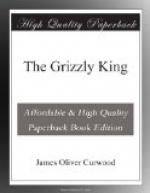Late in October they swung westward through the Sissipuk and Burntwood water ways to Nelson House, and at this point Rameses returned homeward. Roscoe struck north, with two new guides, and on the eighteenth of November the first of the two great storms which made the year of 1907 one of the most tragic in the history of the far Northern people overtook them on Split Lake, thirty miles from a Hudson’s Bay post. It was two weeks later before they reached this post, and here Roscoe was given the first of several warnings.
“This has been the worst autumn we’ve had for years,” said the factor to him. “The Indians haven’t caught half enough fish to carry them through, and this storm has ruined the early-snow hunting in which they usually get enough meat to last them until spring. We’re stinting ourselves on our own supplies now, and farther north the Company will soon be on famine rations if the cold doesn’t let up—and it won’t. They won’t want an extra mouth up there, so you’d better turn back. It’s going to be a starvation winter.”
But Roscoe, knowing as little as the rest of man-kind of the terrible famines of the northern people, which keep an area one-half as large as the whole of Europe down to a population of thirty thousand, went on. A famine, he argued, would give him greater opportunity for study.
Two weeks later he was at York Factory, and from there he continued to Fort Churchill, farther up on Hudson’s Bay. By the time he reached this point, early in January, the famine of those few terrible weeks during which more than fifteen hundred people died of starvation had begun. From the Barren Lands to the edge of the southern watershed the earth lay under from four to six feet of snow, and from the middle of December until late in February the temperature did not rise above thirty degrees below zero, and remained for the most of the time between fifty and sixty. From all points in the wilderness reports of starvation came to the Company’s posts. Traplines could not be followed because of the intense cold. Moose, caribou, and even the furred animals had buried themselves under the snow. Indians and halfbreeds dragged themselves into the posts. Twice Roscoe saw mothers who brought dead babies in their arms. One day a white trapper came in with his dogs and sledge, and on the sledge, wrapped in a bear skin, was his wife, who had died fifty miles back in the forest.
Late in January there came a sudden rise in the temperature, and Roscoe prepared to take advantage of the change to strike south and westward again, toward Nelson House. Dogs could not be had for love or money, so on the first of February he set out on snowshoes with an Indian guide and two weeks’ supply of provisions. The fifth night, in the wild, Barren country west of the Etawney, his Indian failed to keep up the fire, and when Roscoe investigated he found him half dead with a strange sickness. Roscoe thought of smallpox, the terrible plague that usually




